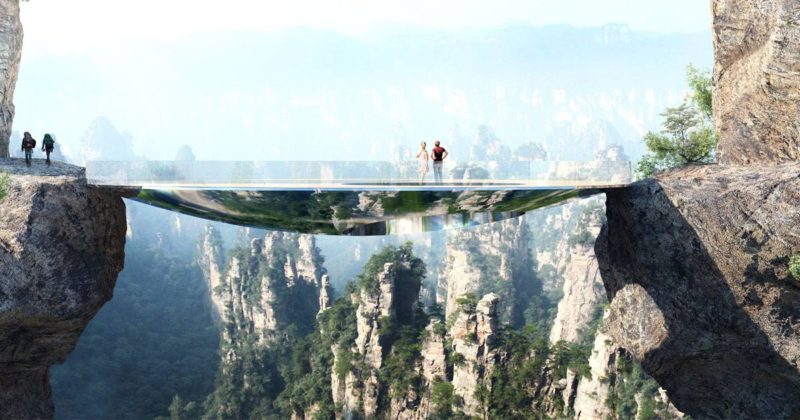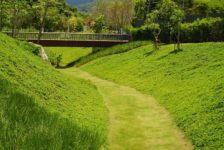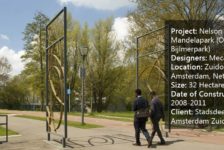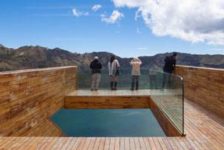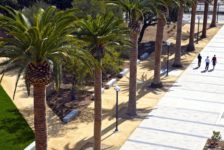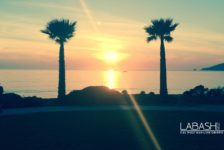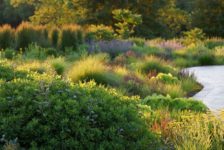Article by Radenka Kolarov – Zhangjiajie Pour, by Martin Duplantier Architectes, in Zhangjiajie, Hunan Province, China. Zhangjiajie Pour project by Martin Duplantier Architectes and Daqian Landscape Architects, in Zhangjiajie, China. This new stainless steel bridge is part of an award-winning concept designed by Martin Duplantier Architectes for the Zhangjiajie World Heritage Site in China. Landscape design for a World Heritage Site is all about treading lightly. And the latest concept for the Zhangjiajie World Heritage Site in Hunan Province, China, does exactly that. Martin Duplantier Architects has released its award-winning plans for pavilions and three scary bridges that will link mountain peaks via a new walkway in the wilderness.

Zhangjiajie Pour. ©Martin Duplantier Architectes
Zhangjiajie Pour
Form, Shape and Structure Three pavilions will be set in the park, offering incredible views to the visitors. Pavilions in the same materials are organized in three levels; from the 360° panorama on the roof – a terrace-panorama directly accessible from the path, to the café in the middle with its dedicated spaces, down to the exclusive VIP suite in the lower level – a royal guesthouse that offers a unique space of contemplation in the heart of the national park; the latter being the visitor’s only means to enjoy a unique night in the middle of this magical landscape. These incorporate space for a terrace, a cafe and a luxury guest house. “After the crowds of the day having disappeared, the lucky tenants will be able to enjoy the spectacle in perfect solitude,” the architects say. Those pavilions are connected with a very special bridge. Set down on the rocks, this step-bridge has two levels to be enjoyed. The upper one connects the two sides, while the lower one is for experiencing a moment “in the air”.

Zhangjiajie Pour. ©Martin Duplantier Architectes

Zhangjiajie Pour. ©Martin Duplantier Architectes
Concept of an Illusion
The concept developed is that of illusionistic geometric development. They are the opportunities, each in its own respect, to create a physical relationship with this rock face. The company’s concept, which was a competition entry, plays on the idea of illusion and stealth; the illusion of a mirror for the first, the fear of the void for the next, and lastly the setting of an abyss for the final.

Zhangjiajie Pour. ©Martin Duplantier Architectes

Zhangjiajie Pour. ©Martin Duplantier Architectes
Another Jewel of China
Zhangjiajie Pour is a project by Martin Duplantier Architectes and Daqian Landscape Architects in the city of Zhangjiajie. The project is located in the Zhangjiajie National Park which is one of the most important natural wonders of the country and it is a true geological museum of China. If this has made you want to go straight to Zhangjiajie we recommend that you might prefer the period of September through October. You will enjoy a pleasant time while you enjoy a refreshing landscape and these astonishing pavilions connected with the remarkable bridge in the center of Zhangjiajie National Park. Would you be brave enough to visit such a place as a Zhangjiajie Pour? Let us know in the comment section below!
Full Project Credits For Zhangjiajie Pour:
Project Name: Zhangjiajie Pour Location: Zhangjiajie, Hunan Province, China Client: ZTG Dates: Winner of the 2015 International Competition. Construction periods should be done in 2018. Landscape Architects: Martin Duplantier Architectes, Daqian Landscape Architects Recommended Reading:
- Becoming an Urban Planner: A Guide to Careers in Planning and Urban Design by Michael Baye
- Sustainable Urbanism: Urban Design With Nature by Douglas Farrs
- eBooks by Landscape Architects Network



